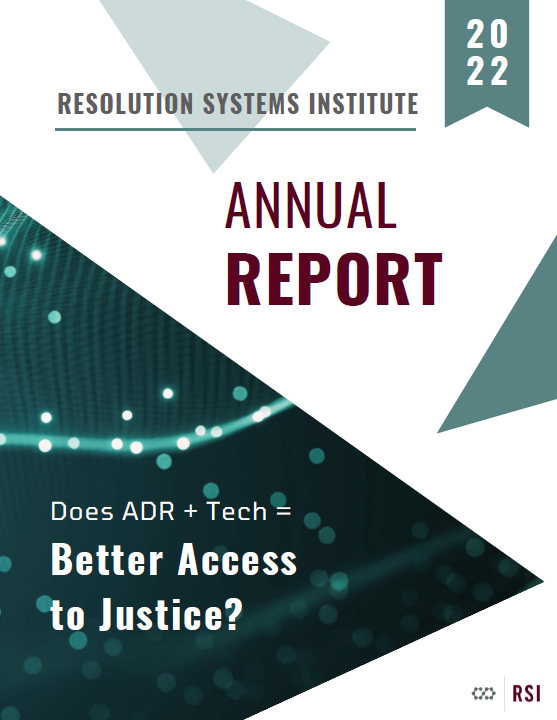RSI Director of Research Jennifer Shack often uses this space to tell us about a new research project or share findings from her latest ADR program evaluation. Today, we asked her to take a step back and answer a few questions about what drives her work, as well as share her thoughts on a few “big questions” in our field.
What drew you to studying alternative dispute resolution (ADR) as a career?
When I was a Peace Corps volunteer in Benin, West Africa, I observed how the village chiefs resolved conflicts through what I was to discover was mediation. I thought it would be great to have something similar here in the States – a way to resolve conflicts without court intervention and in a way in which both parties felt was fair. I was surprised to learn about mediation when I returned home, and excited when I saw an ad for a job opening that started with the words “Interested in mediation?” I applied, and 24 years later I’m still enjoying my work at RSI.
What is your favorite part of your work?
So much! I really enjoy designing evaluations and research projects. I love interviewing program participants and conducting focus groups because I get to learn on a much deeper level how mediation programs affect the participants – and because I get to meet so many interesting people. I also have a lot of fun digging into data to find out what story they tell about a program or an issue and then writing that story.
Do you have a long-term wish list in terms of aspects of court-based ADR that you’d like to study?
I have a lot of items on my wish list. I’ll just talk about my top three. As you know, Donna Shestowsky and I evaluated two text-based ODR programs. I have also evaluated programs that involved in-person and video mediation. I would love to delve further into how these three different processes affect participant experience, particularly in what and how they communicate with each other and the mediator, and whether agreement terms differ. The more we know about how these processes are experienced by parties, the better we can become at determining which method best fits with different case types and situations, and the more we can improve the participant experience.
I would also love to do longitudinal research on child protection mediation. Having conducted a couple of evaluations on child protection mediation programs and interviewed parents after they participated in mediation, I think this is one of the best uses of mediation. But I’d like to know more about its long-term impact on families.
My third item on my wish list is already starting to become true. For decades, I and so many others have wanted to look inside the black box of mediation and find out what works and what doesn’t. We’re starting to do this with the Mediator Trust Project, but that’s only the first step. There are many aspects that can be examined. For example, in family mediation we can examine mediation’s effect on co-parenting and family dynamics. Another possibility is researching whether there are certain things mediators do that increase the probability of impasse.
RSI’s research team has recently expanded to include two additional full-time employees. How has this affected your day-to-day work or RSI’s project work?

Having Rachel and Jasmine join us has been wonderful. It’s really helpful to be able to talk through ideas and issues with other research-minded colleagues. I also am happy to have Jas do research on an idea that I otherwise wouldn’t have time to explore. But most of all having Rachel take leadership on our OPEN Project has allowed me to focus on our Mediator Trust Project while Jasmine continues to monitor and report on the participant surveys from the eviction mediation program RSI administers.
What trends do you see in court-based ADR that you think are likely to persist?
I think remote dispute resolution is here to stay, whether it’s video mediation or text-based ODR. Video mediation will continue to be prevalent, and I’m seeing signs that text-based ODR is going to become much more common in the near future. Artificial intelligence (AI) will make inroads in dispute resolution, particularly in helping parties to negotiate and write agreements. AI may also one day mediate between parties as well.
Outside of technology, I believe courts will continue to implement ADR to address crises, as we have seen with foreclosure and eviction. My optimistic side leads me to think that more courts will treat such cases holistically, attempting to resolve not just the dispute but the problems that led to the dispute in the first place – for example, providing housing and financial counseling to parties at risk of homelessness.
What is your least favorite part of your work?
Probably not having the time or money to pursue all the projects I’d like to do.
What do you see as keys to making court-based ADR more accessible?
The main thing is to break down barriers to participation. This means making the ADR process easier to navigate and use. It also means communicating with parties using multiple methods and keeping in mind best practices for individuals with low literacy. Courts need to ensure that parties know about the existence of ADR options. Donna Shestowsky’s research on civil court ADR and our evaluations of court ODR programs have shown that too many parties don’t know that ADR programs exist. Courts should also educate parties about the benefits and risks of their options if they have them, so they can make informed decisions about those options.







